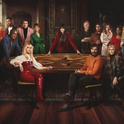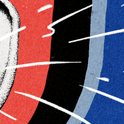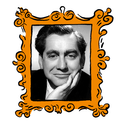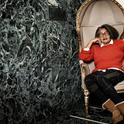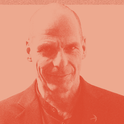Love couple in studio (Two Nudes), Ernst Ludwig Kirchner (1880-1938): “we have misplaced the human element of love”
One Tuesday 400 years ago, an unwed man and woman stood before magistrates in Westminster. They’d had sex together, it was alleged. He denied it; she, having given birth to a bastard child, confessed. A jury found both Robert Watson and Susan Perry guilty. Judges sentenced them to be stripped from the waist up and tied to a cart, then whipped all the way to Temple Bar some two miles away. From there, they would be banished from London, severing them from their homes, families and livelihoods. It is not known what became of their baby.
True and far from unique, this 17th-century story opens historian Faramerz Dabhoiwala’s first book, The Origins of Sex (Allen Lane). We’ve come a long way since then. Consenting adults are largely free to have sex with whomever they please, however they please, whenever they please. A child born out of wedlock is no longer stigmatised. Yet are we really so liberated? The permissiveness of our era can feel like its own form of restrictiveness—we can take any attitude to sex except not wanting it. It has become hard to tune out pop culture’s sexualised clamour, where everything from tweens’ T-shirts to The Archers is sexed up.
The more casual we become about sex, the tighter we cling to an idealised view of love. Love embodies the mystery that sex held before we threw open the bedroom door. We await that transformative “spark,” deferring those three enchanted words “I love you” with the same heated anticipation and trepidation once reserved for sex. But even love has come under attack. In banishing religion from our intimate affairs over the past century, we’ve let science in, neutering and depersonalising our passions by explaining them away as biological urges over which we have no real control. We have misplaced the human element of love.
The story of how we got here and where this leaves us now is the subject of a new crop of books. In the first, Dabhoiwala, a senior fellow in history at Exeter College, Oxford, describes how the English-speaking world journeyed from an essentially medieval attitude to “a new openness about sex” between 1600 and 1800. This, he declares, was the first sexual revolution.
It’s a loping, loose narrative that encompasses the origins of sexual celebrity and scandal, the emergence of the word pornography, and the rise of the notion that sex is a private matter. Women, during this time, went from being deemed innately lascivious to the innocent victims of male libido, prompting the rise of the double standard that haunts us today: a male sexual adventurer is envied, admired even; his female counterpart is a slut.
The Enlightenment, the splintering of Christian doctrine, the ascent of cities, the growing influence of the media—all these and more play their part in this drama. Individuals do their bit, too, from philosophers and social reformers to rakes and novelists. This transition to relative sexual freedom was, Dabhoiwala admits, “largely a jumbled, unconscious process”—one that his narrative mirrors rather too closely in places. It seems a stretch to describe this ragtag sequence of events as a revolution.
“Sexual liberty was not a string of agreed conclusions but a set of ideas amenable to many different interpretations,” Dabhoiwala notes midway through the book. “As a culture, our answers keep changing; and we can never agree entirely… But that is the price we pay for trying to base our moral values on reason, rather than on divine commandments.” This is a view shared by French philosopher Pascal Bruckner. “The liberation of morals obliges us to construct our own rules,” he writes in his new book The Paradox of Love (Princeton). Judging from the picture he paints, we’re making a poor job of it. Far from reducing our responsibilities, he argues, sexual freedom increases them.
Having lived through the giddy years of that more recent sexual revolution, the one famously credited by Philip Larkin as having started sexual intercourse in 1963, Bruckner looks around with dismay, finding a world denuded of true erotic complexity despite our dogged experimentation. Rampant “Dona Juanas” race to tag themselves “sluts,” amateur porn has become as bourgeois as cooking and gardening, and fleeting sensation is prized over lasting emotion. Even affairs have lost their sizzle, says Bruckner. Where once two people liaised to pursue pleasure, now they merely collide in search of their authentic selves. The philanderer’s mantra? “I am unfaithful out of fidelity to myself.”
The problem we face, according to Bruckner, is that the sexual revolution’s defining tenet, free love, is oxymoronic. “How can love, which attaches, be compatible with freedom, which separates?” he asks with logic disarming enough to make even Cupid lower his bow awhile.
We’ve removed this paradox by simply reducing free love to sex. We often note the way this takes the romance out of sex, but it also dulls the sexual element of love, allowing it to become mawkish and overly sentimental. In our hypersexualised world, love has lost its fire, leaving us with what Bruckner characterises as “Insipid paradises of the corny on the one hand and frenetic couplings on the other.”
Meanwhile, science has leapt into love’s place as sex’s bedfellow. Pheromones, vasopressin, oxytocin, endorphins, neuroendocrine systems—these words now vie with the poets’ vocabulary. It’s a strand of discourse typified by evolutionary anthropologist Robin Dunbar in The Science of Love and Betrayal (Faber).
Much of the research he quotes will be familiar—the peacock’s tail, the potent allure of symmetry and so on. Occasionally, though, his workaday prose will yield a gem. Take, if you will, the chemical in male mouse urine. So irresistible is it to female mice that it’s named “darcin” after Mr Darcy. Jane Austen’s novels make a further appearance, too: ruminating on the fate of picky women, Dunbar preaches that they must accept the “curate option” or else meet their biological comeuppance.
Ultimately, Dunbar’s outlook is blinkered by his academic discipline. The idea that men are going about their business with the sole aim of having as many kids as possible will come as a surprise to any single woman in her thirties. But what do women, or for that matter, men know about what they really want? For this book comes with a thumping caveat, which Dunbar tries to slip in unnoticed: “In real life, we are, of course, only dimly conscious of these processes at best… Seems like the best thing to do is just lie back, switch off and let nature take its course.” Just like that, he strips humans of free will. There’s no point trying to argue, either—how can we deny something we’re not fully conscious of in the first place? The idea that in the 21st century we are masters of our erotic destinies is, in Dunbar’s view, rather unconvincing.
A historian, a philosopher and an evolutionary anthropologist—if they met in a bar to chat about love, you’d have the makings of a risqué joke. But among the authors of these new books, it is a sociologist, Jean-Claude Kaufmann, who confronts the biggest development in the world of love and sex over the past two decades: the internet.
In Love Online (Polity), Kaufmann opens up the world of Francophone online dating, trawling blogs and chatrooms for case studies that bear intimate witness to the digital revolution as it’s playing out in the heart—and loins.
These online exhibitionists go by aliases like “Mistral” and “Poupine,” but Kaufmann’s study mostly shows how the internet, far from transforming our love lives, simply compounds existing contradictions rooted in the 1960s, or back in Dabhoiwala’s 17th century, or even, as Dunbar would have it, a time before we acquired language. Confused ideas such as our mismatched desire for togetherness and individualism, the pretence that the double standard has been erased, and the idealised notions of romance that conceal our mercenary assessment of prospective mates—they are all exacerbated by the internet’s instantaneity and impersonality.
Crucially on the internet, just as in the real world, people’s desires often conflict. Some want “sex dates,” others are looking for their soulmate. For this particular problem, Kaufmann has a solution, something he dubs “LoveSex,” a fleeting intimacy that nevertheless includes tenderness. Think of it as friends with benefits and then some. It’s a nice idea in theory, but the reality would surely be messier. As Kaufmann concedes, our desires and feelings are rogue entities that we cannot easily control.
It is the unruliness of these feelings that has led every society to develop its own set of rigidly policed sexual norms. Our own age, for all its justly treasured liberties, is no different. Though private, the idea of sex is still constructed communally, and subject to changes in taste and fashion. Talking about it remains circumscribed too. In magazines, for instance, the discussion is mechanistic—endless technique tips coupled with a squeamishness where emotions are concerned. This entrenches the idea that there’s a right and a wrong way of going about it (just flip through those same magazines—directives dolled up as advice). We’ve traded naivety for the enslaving belief that we all must be sexual Olympians. It all becomes a bit of a turn-off. To quote Bruckner again: “Our parents lied about their morality; we lie about our immorality.”
It all casts abstention in the unlikely role of last remaining sexual taboo, embraced by pop stars looking to shock. That wasn’t what I was looking to do when I published a book in 2009 about my own elected year without sex. I hoped to map a fresh and less wrenching way of searching for love in an age of casual intimacy. I was navigating the same choppy waters that Bruckner charts, asserting, like Kaufmann’s defiant blogger “Nina,” my “right to become fond of someone.” My motivations were numerous and personal, but there was also this: it seemed to me that for women, the legacy of the sexual revolution of the 1960s—which in turn had its roots in the period Dabhoiwala chronicles—was the right to have sex as men are expected to want it: powering ever onwards from conquest to conquest, hardwired to sow wild oats without glancing back.
I was reminded of this reading these books (all by men, of course). In all the upheaval that they collectively survey, almost nothing has been done to feminise sex. What would this entail? Female sexuality has been so shaped by social mores that even clinical researchers despair of disentangling nature and nurture. Yet I can’t help thinking that that really would be a revolution.
One Tuesday 400 years ago, an unwed man and woman stood before magistrates in Westminster. They’d had sex together, it was alleged. He denied it; she, having given birth to a bastard child, confessed. A jury found both Robert Watson and Susan Perry guilty. Judges sentenced them to be stripped from the waist up and tied to a cart, then whipped all the way to Temple Bar some two miles away. From there, they would be banished from London, severing them from their homes, families and livelihoods. It is not known what became of their baby.
True and far from unique, this 17th-century story opens historian Faramerz Dabhoiwala’s first book, The Origins of Sex (Allen Lane). We’ve come a long way since then. Consenting adults are largely free to have sex with whomever they please, however they please, whenever they please. A child born out of wedlock is no longer stigmatised. Yet are we really so liberated? The permissiveness of our era can feel like its own form of restrictiveness—we can take any attitude to sex except not wanting it. It has become hard to tune out pop culture’s sexualised clamour, where everything from tweens’ T-shirts to The Archers is sexed up.
The more casual we become about sex, the tighter we cling to an idealised view of love. Love embodies the mystery that sex held before we threw open the bedroom door. We await that transformative “spark,” deferring those three enchanted words “I love you” with the same heated anticipation and trepidation once reserved for sex. But even love has come under attack. In banishing religion from our intimate affairs over the past century, we’ve let science in, neutering and depersonalising our passions by explaining them away as biological urges over which we have no real control. We have misplaced the human element of love.
The story of how we got here and where this leaves us now is the subject of a new crop of books. In the first, Dabhoiwala, a senior fellow in history at Exeter College, Oxford, describes how the English-speaking world journeyed from an essentially medieval attitude to “a new openness about sex” between 1600 and 1800. This, he declares, was the first sexual revolution.
It’s a loping, loose narrative that encompasses the origins of sexual celebrity and scandal, the emergence of the word pornography, and the rise of the notion that sex is a private matter. Women, during this time, went from being deemed innately lascivious to the innocent victims of male libido, prompting the rise of the double standard that haunts us today: a male sexual adventurer is envied, admired even; his female counterpart is a slut.
The Enlightenment, the splintering of Christian doctrine, the ascent of cities, the growing influence of the media—all these and more play their part in this drama. Individuals do their bit, too, from philosophers and social reformers to rakes and novelists. This transition to relative sexual freedom was, Dabhoiwala admits, “largely a jumbled, unconscious process”—one that his narrative mirrors rather too closely in places. It seems a stretch to describe this ragtag sequence of events as a revolution.
“Sexual liberty was not a string of agreed conclusions but a set of ideas amenable to many different interpretations,” Dabhoiwala notes midway through the book. “As a culture, our answers keep changing; and we can never agree entirely… But that is the price we pay for trying to base our moral values on reason, rather than on divine commandments.” This is a view shared by French philosopher Pascal Bruckner. “The liberation of morals obliges us to construct our own rules,” he writes in his new book The Paradox of Love (Princeton). Judging from the picture he paints, we’re making a poor job of it. Far from reducing our responsibilities, he argues, sexual freedom increases them.
Having lived through the giddy years of that more recent sexual revolution, the one famously credited by Philip Larkin as having started sexual intercourse in 1963, Bruckner looks around with dismay, finding a world denuded of true erotic complexity despite our dogged experimentation. Rampant “Dona Juanas” race to tag themselves “sluts,” amateur porn has become as bourgeois as cooking and gardening, and fleeting sensation is prized over lasting emotion. Even affairs have lost their sizzle, says Bruckner. Where once two people liaised to pursue pleasure, now they merely collide in search of their authentic selves. The philanderer’s mantra? “I am unfaithful out of fidelity to myself.”
The problem we face, according to Bruckner, is that the sexual revolution’s defining tenet, free love, is oxymoronic. “How can love, which attaches, be compatible with freedom, which separates?” he asks with logic disarming enough to make even Cupid lower his bow awhile.
We’ve removed this paradox by simply reducing free love to sex. We often note the way this takes the romance out of sex, but it also dulls the sexual element of love, allowing it to become mawkish and overly sentimental. In our hypersexualised world, love has lost its fire, leaving us with what Bruckner characterises as “Insipid paradises of the corny on the one hand and frenetic couplings on the other.”
Meanwhile, science has leapt into love’s place as sex’s bedfellow. Pheromones, vasopressin, oxytocin, endorphins, neuroendocrine systems—these words now vie with the poets’ vocabulary. It’s a strand of discourse typified by evolutionary anthropologist Robin Dunbar in The Science of Love and Betrayal (Faber).
Much of the research he quotes will be familiar—the peacock’s tail, the potent allure of symmetry and so on. Occasionally, though, his workaday prose will yield a gem. Take, if you will, the chemical in male mouse urine. So irresistible is it to female mice that it’s named “darcin” after Mr Darcy. Jane Austen’s novels make a further appearance, too: ruminating on the fate of picky women, Dunbar preaches that they must accept the “curate option” or else meet their biological comeuppance.
Ultimately, Dunbar’s outlook is blinkered by his academic discipline. The idea that men are going about their business with the sole aim of having as many kids as possible will come as a surprise to any single woman in her thirties. But what do women, or for that matter, men know about what they really want? For this book comes with a thumping caveat, which Dunbar tries to slip in unnoticed: “In real life, we are, of course, only dimly conscious of these processes at best… Seems like the best thing to do is just lie back, switch off and let nature take its course.” Just like that, he strips humans of free will. There’s no point trying to argue, either—how can we deny something we’re not fully conscious of in the first place? The idea that in the 21st century we are masters of our erotic destinies is, in Dunbar’s view, rather unconvincing.
A historian, a philosopher and an evolutionary anthropologist—if they met in a bar to chat about love, you’d have the makings of a risqué joke. But among the authors of these new books, it is a sociologist, Jean-Claude Kaufmann, who confronts the biggest development in the world of love and sex over the past two decades: the internet.
In Love Online (Polity), Kaufmann opens up the world of Francophone online dating, trawling blogs and chatrooms for case studies that bear intimate witness to the digital revolution as it’s playing out in the heart—and loins.
These online exhibitionists go by aliases like “Mistral” and “Poupine,” but Kaufmann’s study mostly shows how the internet, far from transforming our love lives, simply compounds existing contradictions rooted in the 1960s, or back in Dabhoiwala’s 17th century, or even, as Dunbar would have it, a time before we acquired language. Confused ideas such as our mismatched desire for togetherness and individualism, the pretence that the double standard has been erased, and the idealised notions of romance that conceal our mercenary assessment of prospective mates—they are all exacerbated by the internet’s instantaneity and impersonality.
Crucially on the internet, just as in the real world, people’s desires often conflict. Some want “sex dates,” others are looking for their soulmate. For this particular problem, Kaufmann has a solution, something he dubs “LoveSex,” a fleeting intimacy that nevertheless includes tenderness. Think of it as friends with benefits and then some. It’s a nice idea in theory, but the reality would surely be messier. As Kaufmann concedes, our desires and feelings are rogue entities that we cannot easily control.
It is the unruliness of these feelings that has led every society to develop its own set of rigidly policed sexual norms. Our own age, for all its justly treasured liberties, is no different. Though private, the idea of sex is still constructed communally, and subject to changes in taste and fashion. Talking about it remains circumscribed too. In magazines, for instance, the discussion is mechanistic—endless technique tips coupled with a squeamishness where emotions are concerned. This entrenches the idea that there’s a right and a wrong way of going about it (just flip through those same magazines—directives dolled up as advice). We’ve traded naivety for the enslaving belief that we all must be sexual Olympians. It all becomes a bit of a turn-off. To quote Bruckner again: “Our parents lied about their morality; we lie about our immorality.”
It all casts abstention in the unlikely role of last remaining sexual taboo, embraced by pop stars looking to shock. That wasn’t what I was looking to do when I published a book in 2009 about my own elected year without sex. I hoped to map a fresh and less wrenching way of searching for love in an age of casual intimacy. I was navigating the same choppy waters that Bruckner charts, asserting, like Kaufmann’s defiant blogger “Nina,” my “right to become fond of someone.” My motivations were numerous and personal, but there was also this: it seemed to me that for women, the legacy of the sexual revolution of the 1960s—which in turn had its roots in the period Dabhoiwala chronicles—was the right to have sex as men are expected to want it: powering ever onwards from conquest to conquest, hardwired to sow wild oats without glancing back.
I was reminded of this reading these books (all by men, of course). In all the upheaval that they collectively survey, almost nothing has been done to feminise sex. What would this entail? Female sexuality has been so shaped by social mores that even clinical researchers despair of disentangling nature and nurture. Yet I can’t help thinking that that really would be a revolution.

